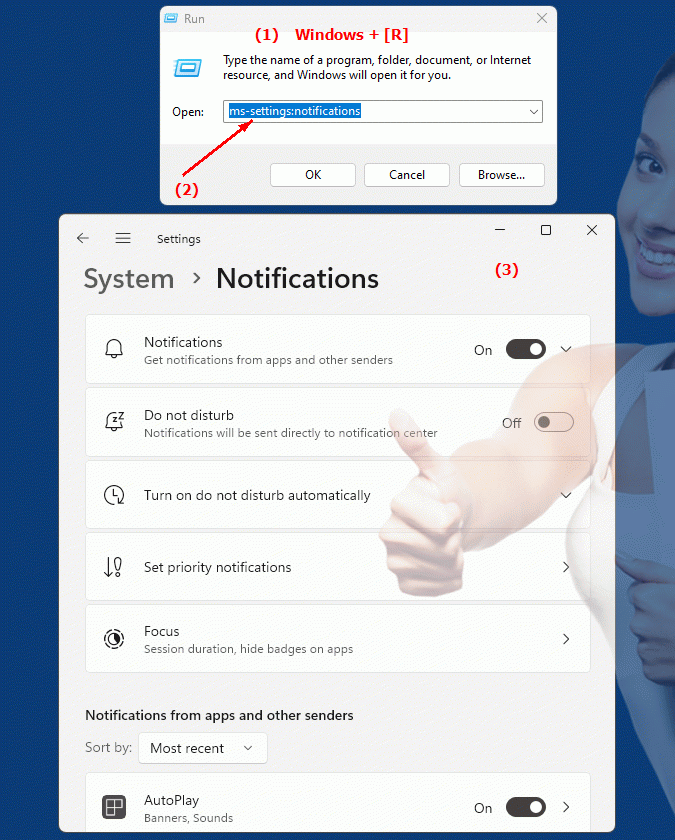The URL "ms-settings:notifications" opens the Notifications settings in Windows 10 und 11 .
These settings allow users to control how and when they receive notifications from various apps and system components. Here is a detailed description of the availability of this feature in different versions of Windows, along with the corresponding build numbers:
1. ms-settings:notifications
2. Availability under Windows
3. Other useful commands in the Windows settings
1. The Command ms-settings:notifications
1. Open the Run window using Windows R.2. All you need to do is use the command: ms-settings:notifications
(You can also use the command to create a desktop shortcut.)
3. You can confirm by pressing the OK button or [Enter].
(... see Image-1 Point 1 to 3)
The settings described in Windows 10, 11 or 12 are now available to you. You can now access the options explained above in your Windows 10, 11 or 12.
This can answer the following challenges and questions.

1b. This can answer the following challenges and questions.
How do I change notification settings in Windows?Where can I find the notification settings in Windows 10?
Can I configure the type of notifications in Windows?
How do I set notification settings for a specific app in Windows?
What are the notification settings options in Windows 10?
Can I change the time of saving notifications in Windows?
How do I enable or disable notifications for an app in Windows?
What is the difference between notification settings in different versions of Windows?
How do I change system update notifications in Windows?
Can I customize the display of notifications in Windows?
2. Availability in Windows 10, 11 and 12 versions and the correct build numbers.
Windows10
- Availability:
Notification settings have been supported in Windows 10 since the beginning. The "ms-settings:notifications" URL provides users with access to options for managing notifications, including the ability to enable or disable notifications for specific apps, customize notification sounds, and configure other notification options.
- Build number:
The "ms-settings:notifications" URL is available in Windows 10 starting with version 1507 (Build 10240). This is the original version of Windows 10 released on July 29, 2015. Starting with this version, users can manage notification settings directly from this URL.
Windows11
- Availability:
Windows 11 introduces a modernized notification settings UI, but sticks with the basic structure of notification management. The "ms-settings:notifications" URL remains relevant and provides access to the updated notification settings in Windows 11.
- Build number:
The "ms-settings:notifications" URL is available in Windows 11 starting with version 21H2 (Build 22000), released on October 5, 2021. In Windows 11, notification settings have been updated to provide a better user experience and new options, including the integration of new features like the “Focus Assist” feature.
Windows12
- Availability:
Windows 12 is expected to continue to support the Notification Management feature, possibly with additional features and improvements to align with the latest developments in notifications and user experience. Windows 12 could offer new options to customize and manage notifications.
- Build number:
The exact build number for the feature's introduction in Windows 12 will be provided after the first versions of the operating system are released. However, the "ms-settings:notifications" URL is expected to be available from the early builds of Windows 12 and will include the latest notification management features.
Summary
The "ms-settings:notifications" URL is available in Windows 10 starting with version 1507 (build 10240) and remains available in Windows 11 starting with version 21H2 (build 22000) as well as in Windows 12. This URL allows users to directly access the notification settings to use various options to manage and customize notifications from apps and system components. The exact build number for Windows 12 will be provided after the initial releases, but the feature is expected to be included in the early versions of the new operating system.
